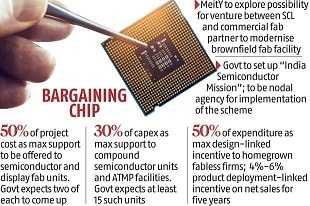Our Semicon Report card
Current Context:
- The recent historic visit of the Prime Minister of India to the US led to a crucial agreement. Both nations agreed to partner in developing critical technologies that will shape our future — artificial intelligence, semiconductors, quantum computing, high-performance computing, and space.
- Recently, a US-based Company – Micron Technology, has signed a Memorandum of Understanding (MoU) with the state government of Gujarat to establish a Semiconductor Unit.
India Semiconductor Mission-
- India Semiconductor Mission (ISM) has been set up as an Independent Business Division within Digital India Corporation.
- ISM has all the administrative and financial powers and is tasked with the responsibility of catalyzing the India Semiconductor ecosystem in manufacturing, packaging, and design.
- ISM has an advisory board consisting of some of the leading global experts in the field of semiconductors.
- ISM is serving as the nodal agency for efficient, coherent, and smooth implementation of the program for the development of the semiconductor and manufacturing ecosystem in India.
Objectives of ISM are as under:
- Formulate a comprehensive long-term strategy for developing sustainable semiconductors and display manufacturing facilities.
- Facilitate the adoption of secure microelectronics and develop a trusted semiconductor supply chain, including raw materials, specialty chemicals, gases, and manufacturing equipment.
- Enable a multi-fold growth of the Indian semiconductor design industry by providing requisite support.
- Promote and facilitate indigenous Intellectual Property (IP) generation.
- Encourage, enable, and incentivize the Transfer of Technologies (ToT).
- Establish suitable mechanisms to harness economies of scale in the Indian semiconductor and display industry.
- Enable cutting-edge research in the semiconductors and display industry including evolutionary and revolutionary technologies through grants
- Enable collaborations and partnership programs with national and international agencies, industries, and institutions.
Significance of Semiconductors:
- Semiconductors and displays are the foundation of modern electronics driving the next phase of digital transformation under Industry 4.0.
- Semiconductors are essential to almost all sectors of the economy including aerospace, automobiles, communications, clean energy, information technology and medical devices etc.
- The high demand for these critical components has outstripped supply, created a global chip shortage, and resulted in lost growth and jobs in the economy.
It is brimming with milestones & India is now at an inflection point-
- Independent India’s history is replete with instances of how India missed the semiconductor and electronics bus. However, India is rebuilding its’s electronics ecosystem, making it one of the fastest-growing across the world.
- With setting a goal of a $1 trillion digital economy, aiming for it to contribute 20 percent to GDP.
- India is now being recognized as a trusted partner for various global challenges, ranging from sustainability and security to vaccines, electronics, and semiconductors.
- ISM initiative has contributed significantly to the expansion of the digital and innovation economy and secured a substantial share in the global semiconductor market.
- It has also catalyzed the growth of semiconductor design startups and supported India’s global partnerships with global majors.
Challenges:
- Lack of political and strategic vision and incompetence.
- Lack of natural resources and infrastructure.
- Lack of skills, which are required to chip designing as well as mining of resources.
- It is a very complex and technology-intensive sector involving huge capital investments, high risk, long gestation and payback periods, and rapid changes in technology, which require significant and sustained investments.
Conclusion:
- India should also explore the opportunities to collaborate with other countries such as Taiwan and Japan or other technologically advanced, friendly nations to promote domestic manufacturing and reduce import dependency in the Semiconductor Sector.
- India must also improvise research and development in this sector which is lacking.
- Instead of the dream of swadeshi semiconductors, India should aim to become a key player in a trusted, plurilateral semiconductor ecosystem that keeps key adversaries out.





